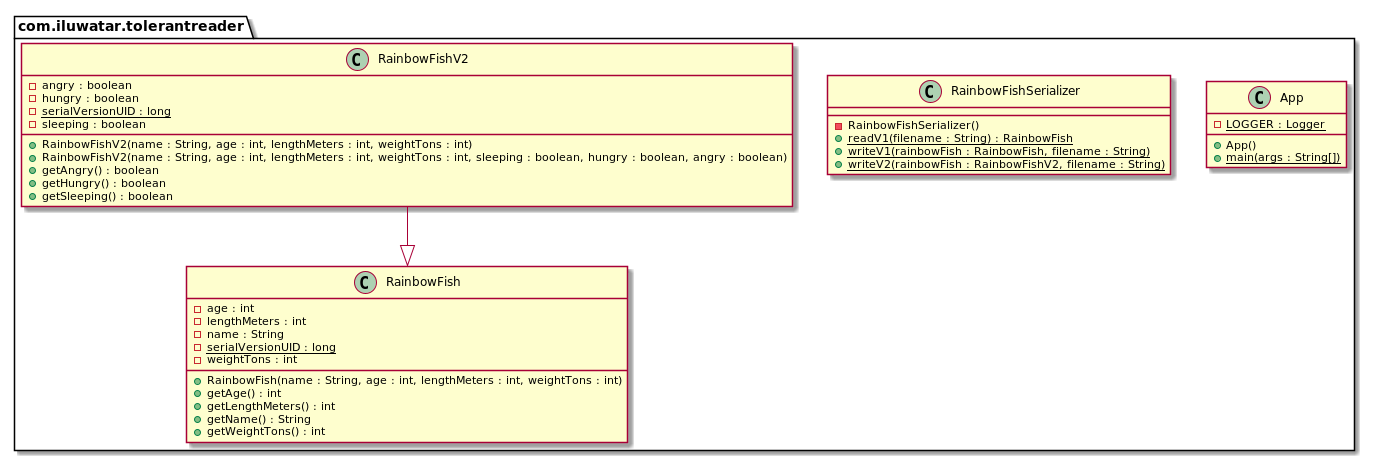Tolerant Reader
Intent
Tolerant Reader is an integration pattern that helps creating robust communication systems. The idea
is to be as tolerant as possible when reading data from another service. This way, when the
communication schema changes, the readers must not break.
Explanation
Real world example
We are persisting rainbowfish objects to file and later on they need to be restored. What makes it
problematic is that rainbowfish data structure is versioned and evolves over time. New version of
rainbowfish needs to be able to restore old versions as well.
In plain words
Tolerant Reader pattern is used to create robust communication mechanisms between services.
Robustness Principle says
Be conservative in what you do, be liberal in what you accept from others.
Programmatic Example
Here's the versioned RainbowFish. Notice how the second version introduces additional properties.
public class RainbowFish implements Serializable {
private static final long serialVersionUID = 1L;
private final String name;
private final int age;
private final int lengthMeters;
private final int weightTons;
/**
* Constructor.
*/
public RainbowFish(String name, int age, int lengthMeters, int weightTons) {
this.name = name;
this.age = age;
this.lengthMeters = lengthMeters;
this.weightTons = weightTons;
}
public String getName() {
return name;
}
public int getAge() {
return age;
}
public int getLengthMeters() {
return lengthMeters;
}
public int getWeightTons() {
return weightTons;
}
}
public class RainbowFishV2 extends RainbowFish {
private static final long serialVersionUID = 1L;
private boolean sleeping;
private boolean hungry;
private boolean angry;
public RainbowFishV2(String name, int age, int lengthMeters, int weightTons) {
super(name, age, lengthMeters, weightTons);
}
/**
* Constructor.
*/
public RainbowFishV2(String name, int age, int lengthMeters, int weightTons, boolean sleeping,
boolean hungry, boolean angry) {
this(name, age, lengthMeters, weightTons);
this.sleeping = sleeping;
this.hungry = hungry;
this.angry = angry;
}
public boolean getSleeping() {
return sleeping;
}
public boolean getHungry() {
return hungry;
}
public boolean getAngry() {
return angry;
}
}
Next we introduce the RainbowFishSerializer. This is the class that implements the Tolerant Reader
pattern.
public final class RainbowFishSerializer {
private RainbowFishSerializer() {
}
public static void writeV1(RainbowFish rainbowFish, String filename) throws IOException {
var map = Map.of(
"name", rainbowFish.getName(),
"age", String.format("%d", rainbowFish.getAge()),
"lengthMeters", String.format("%d", rainbowFish.getLengthMeters()),
"weightTons", String.format("%d", rainbowFish.getWeightTons())
);
try (var fileOut = new FileOutputStream(filename);
var objOut = new ObjectOutputStream(fileOut)) {
objOut.writeObject(map);
}
}
public static void writeV2(RainbowFishV2 rainbowFish, String filename) throws IOException {
var map = Map.of(
"name", rainbowFish.getName(),
"age", String.format("%d", rainbowFish.getAge()),
"lengthMeters", String.format("%d", rainbowFish.getLengthMeters()),
"weightTons", String.format("%d", rainbowFish.getWeightTons()),
"angry", Boolean.toString(rainbowFish.getAngry()),
"hungry", Boolean.toString(rainbowFish.getHungry()),
"sleeping", Boolean.toString(rainbowFish.getSleeping())
);
try (var fileOut = new FileOutputStream(filename);
var objOut = new ObjectOutputStream(fileOut)) {
objOut.writeObject(map);
}
}
public static RainbowFish readV1(String filename) throws IOException, ClassNotFoundException {
Map<String, String> map;
try (var fileIn = new FileInputStream(filename);
var objIn = new ObjectInputStream(fileIn)) {
map = (Map<String, String>) objIn.readObject();
}
return new RainbowFish(
map.get("name"),
Integer.parseInt(map.get("age")),
Integer.parseInt(map.get("lengthMeters")),
Integer.parseInt(map.get("weightTons"))
);
}
}
And finally here's the full example in action.
var fishV1 = new RainbowFish("Zed", 10, 11, 12);
LOGGER.info("fishV1 name={} age={} length={} weight={}", fishV1.getName(),
fishV1.getAge(), fishV1.getLengthMeters(), fishV1.getWeightTons());
RainbowFishSerializer.writeV1(fishV1, "fish1.out");
var deserializedRainbowFishV1 = RainbowFishSerializer.readV1("fish1.out");
LOGGER.info("deserializedFishV1 name={} age={} length={} weight={}",
deserializedRainbowFishV1.getName(), deserializedRainbowFishV1.getAge(),
deserializedRainbowFishV1.getLengthMeters(), deserializedRainbowFishV1.getWeightTons());
var fishV2 = new RainbowFishV2("Scar", 5, 12, 15, true, true, true);
LOGGER.info(
"fishV2 name={} age={} length={} weight={} sleeping={} hungry={} angry={}",
fishV2.getName(), fishV2.getAge(), fishV2.getLengthMeters(), fishV2.getWeightTons(),
fishV2.getHungry(), fishV2.getAngry(), fishV2.getSleeping());
RainbowFishSerializer.writeV2(fishV2, "fish2.out");
var deserializedFishV2 = RainbowFishSerializer.readV1("fish2.out");
LOGGER.info("deserializedFishV2 name={} age={} length={} weight={}",
deserializedFishV2.getName(), deserializedFishV2.getAge(),
deserializedFishV2.getLengthMeters(), deserializedFishV2.getWeightTons());
Program output:
fishV1 name=Zed age=10 length=11 weight=12
deserializedFishV1 name=Zed age=10 length=11 weight=12
fishV2 name=Scar age=5 length=12 weight=15 sleeping=true hungry=true angry=true
deserializedFishV2 name=Scar age=5 length=12 weight=15
Class diagram

Applicability
Use the Tolerant Reader pattern when
- The communication schema can evolve and change and yet the receiving side should not break